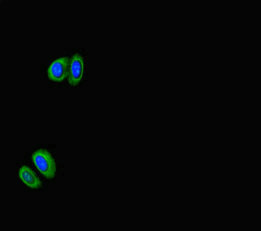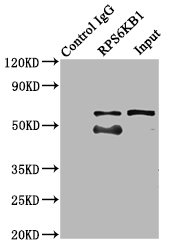
Immunofluorescent analysis of HepG2 cells using CSB-PA020470LA01HU at dilution of 1:100 and Alexa Fluor 488-congugated AffiniPure Goat Anti-Rabbit IgG(H+L)
RPS6KB1 Antibody

CSB-PA020470LA01HU
ApplicationsImmunoFluorescence, ImmunoPrecipitation, ELISA
Product group Antibodies
ReactivityHuman
TargetRPS6KB1
Overview
- SupplierCusabio
- Product NameRPS6KB1 Antibody
- Delivery Days Customer20
- ApplicationsImmunoFluorescence, ImmunoPrecipitation, ELISA
- CertificationResearch Use Only
- ClonalityPolyclonal
- ConjugateUnconjugated
- Gene ID6198
- Target nameRPS6KB1
- Target descriptionribosomal protein S6 kinase B1
- Target synonymsp70 S6KA; p70(S6K)-alpha; p70-alpha; p70-S6K; PS6K; ribosomal protein S6 kinase beta-1; ribosomal protein S6 kinase I; ribosomal protein S6 kinase, 70kDa, polypeptide 1; S6K; S6K1; S6K-beta-1; serine/threonine kinase 14 alpha; serine/threonine-protein kinase 14A; STK14A
- HostRabbit
- IsotypeIgG
- Protein IDP23443
- Protein NameRibosomal protein S6 kinase beta-1
- Scientific DescriptionSerine/threonine-protein kinase that acts downstream of mTOR signaling in response to growth factors and nutrients to promote cell proliferation, cell growth and cell cycle progression. Regulates protein synthesis through phosphorylation of EIF4B, RPS6 and EEF2K, and contributes to cell survival by repressing the pro-apoptotic function of BAD. Under conditions of nutrient depletion, the inactive form associates with the EIF3 translation initiation complex. Upon mitogenic stimulation, phosphorylation by the mammalian target of rapamycin complex 1 (mTORC1) leads to dissociation from the EIF3 complex and activation. The active form then phosphorylates and activates several substrates in the pre-initiation complex, including the EIF2B complex and the cap-binding complex component EIF4B. Also controls translation initiation by phosphorylating a negative regulator of EIF4A, PDCD4, targeting it for ubiquitination and subsequent proteolysis. Promotes initiation of the pioneer round of protein synthesis by phosphorylating POLDIP3/SKAR. In response to IGF1, activates translation elongation by phosphorylating EEF2 kinase (EEF2K), which leads to its inhibition and thus activation of EEF2. Also plays a role in feedback regulation of mTORC2 by mTORC1 by phosphorylating RICTOR, resulting in the inhibition of mTORC2 and AKT1 signaling. Mediates cell survival by phosphorylating the pro-apoptotic protein BAD and suppressing its pro-apoptotic function. Phosphorylates mitochondrial URI1 leading to dissociation of a URI1-PPP1CC complex. The free mitochondrial PPP1CC can then dephosphorylate RPS6KB1 at Thr-412, which is proposed to be a negative feedback mechanism for the RPS6KB1 anti-apoptotic function. Mediates TNF-alpha-induced insulin resistance by phosphorylating IRS1 at multiple serine residues, resulting in accelerated degradation of IRS1. In cells lacking functional TSC1-2 complex, constitutively phosphorylates and inhibits GSK3B. May be involved in cytoskeletal rearrangement through binding to neurabin. Phosphorylates and activates the pyrimidine biosynthesis enzyme CAD, downstream of MTOR.
- ReactivityHuman
- Storage Instruction-20°C or -80°C
- UNSPSC12352203

